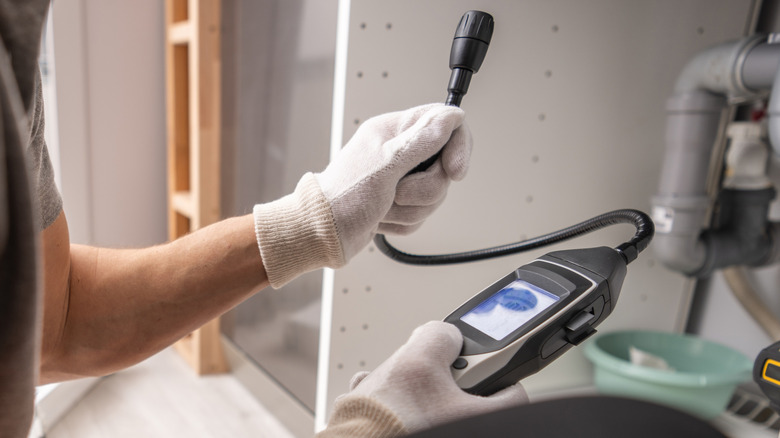The Device Every Gas Stove Owner Should Have That Makes Your Home Safer
We may receive a commission on purchases made from links.
There are a number of good reasons to choose a gas stove. According to the US Department of Environment, gas is as much as 3.5 times cheaper than electricity. Although induction stovetops are one of the trendy kitchen appliances we're seeing more of, professional chefs still prefer gas, and keen home cooks can benefit from the same control and precision. There's one potential drawback that, understandably, concerns some people: safety.
Natural gas doesn't contain anything toxic or poisonous, but, of course, it is highly flammable, which still makes it dangerous. While there are several warning signs of a gas leak in your home, in extreme cases with high concentrations, it could be the cause of a lethal explosion or fire. While you can smell natural gas (thanks to added chemicals that give it a rotting egg smell), you're not always around to smell it, or you might not notice it at first.
So there is an early-warning device every gas stove owner should have to help catch gas leaks early. Not surprisingly, it's called a gas detector. These are not the same as the carbon monoxide detectors that many people fit in their homes (and are essential for homes with gas-powered appliances), so let's look at these devices in a bit more detail.
Types of gas detector and how they work
Gas detectors can be divided into two basic types: handheld or plugin. Handheld models like the Toptes PT199 Natural Gas Leak Detector, available at Amazon, are compact, pen-like devices often called sniffers. This battery-powered model can detect natural gas, propane, methane, and even gasoline fumes and costs under $20. More advanced models have a larger, more informative display and a flexible detector. The drawback with this type is that you need to point it in the vicinity of the leak. That's useful if you want to narrow down where the gas is coming from, but it's not an early warning device that will make your home safer if there's a gas leak while you're asleep, for example.
Plug-in models fit in an ordinary electrical outlet (and can also be used in RVs) and constantly monitor for gas, making them ideal for homes. Those that only detect flammable gases can be found for a similar price as the pen-type sniffers. More advanced models, like Nicgol's 4-in-1 Upgraded Natural Gas Leak Detector, can also detect carbon monoxide. It has dual alarms, both visual and audible, can give actual gas concentration in ppm (parts per million), and costs around $40. Install these detectors near appliances that burn fuel, natural gas entry points, and near bedrooms to make sure you hear the alarm.
Some people argue that there are hidden downsides to gas stoves, and safety could be one of them. However, gas detectors are a relatively minor investment that will make your home safer and give you peace of mind if you're not ready to part with your gas stove.

